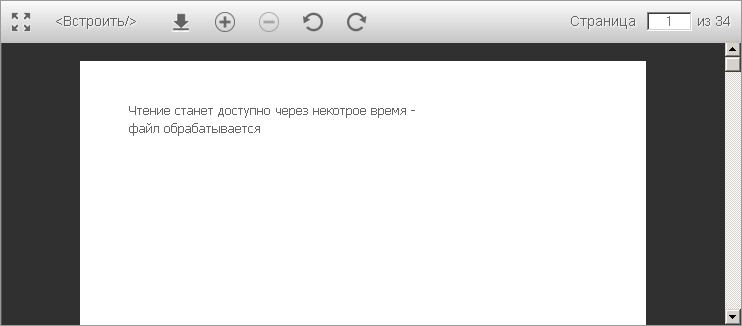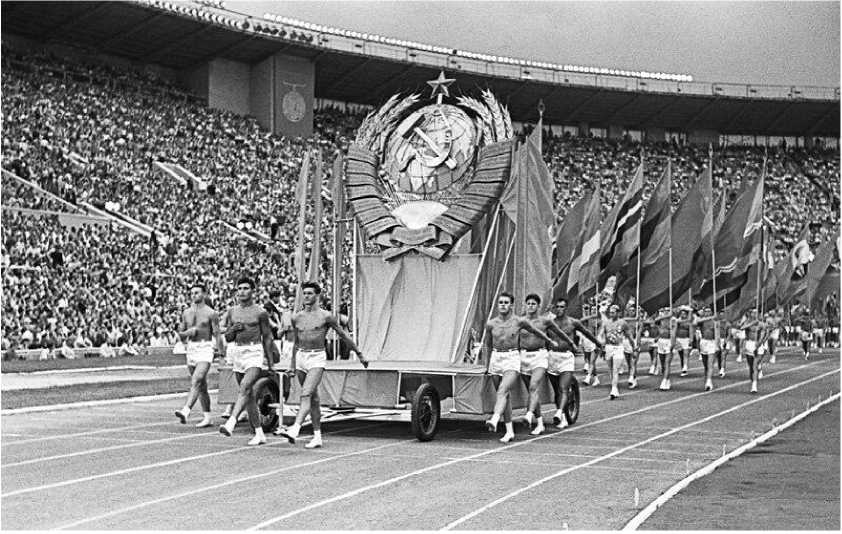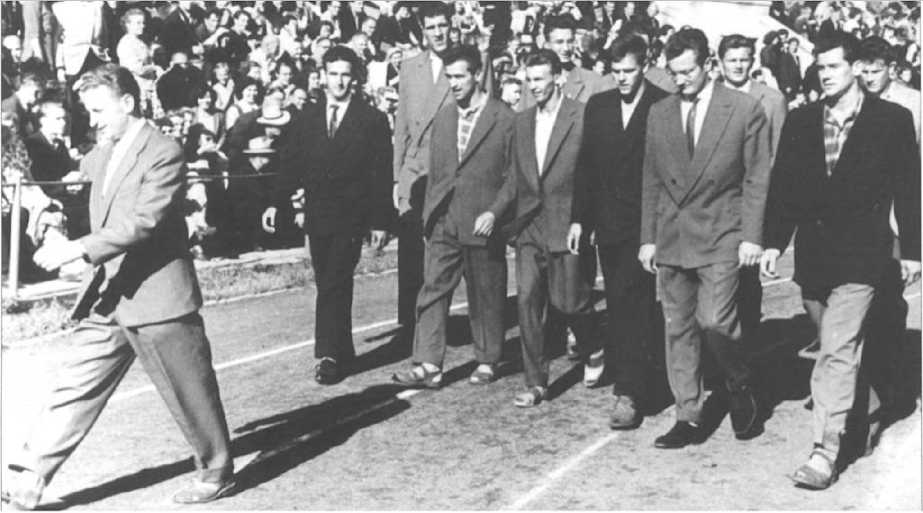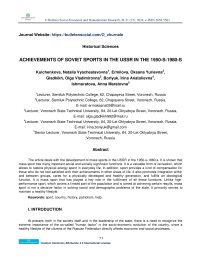Achievements of Soviet Sports in the USSR in the 1950-S-1980-S
Автор: Kulchenkova Natalia Vyacheslavovna, Ermilova Oksana Yurievna, Gladkikh Olga Vladimirovna, Borlyuk Irina Anatolevna, Ishmuratova Anna Maratovna
Журнал: Bulletin Social-Economic and Humanitarian Research @bulletensocial
Статья в выпуске: 21 (23), 2024 года.
Бесплатный доступ
The article deals with the development of mass sports in the USSR in the 1950-s-1980-s. It is shown that mass sport has many important social and socially significant functions. It is a valuable form of recreation, which allows to restore physical energy spent in everyday life. In addition, sport provides a kind of compensation for those who do not feel satisfied with their achievements in other areas of life. It also promotes integration within and between groups, cares for a physically developed and healthy generation, and fulfills an ideological function. It is mass sport that has played a key role in the fulfillment of all these functions. Unlike high-performance sport, which covers a limited part of the population and is aimed at achieving certain results, mass sport is not a decisive factor in solving social and demographic problems of the state. It primarily serves to maintain a healthy lifestyle.
Sport, country, history, patriotism, help
Короткий адрес: https://sciup.org/14130053
IDR: 14130053 | DOI: 10.5281/zenodo.10801551

Текст научной статьи Achievements of Soviet Sports in the USSR in the 1950-S-1980-S
At present, both in the society itself and in the leadership of the state, there is a need to recognize the extreme importance of the so-called "human factor" in the socio-economic evolution of the country, since a healthy lifestyle of the citizens of the Russian Federation directly affects economic and social processes.
As such, the indicators of economic development of the state lose their meaning if there is a parallel deterioration in the health of the nation, if there is a decline in life expectancy everywhere (both among urban and rural populations), if crime is on the rise among young people, and if the number of drug addicts and alcohol abusers is increasing. In this regard, physical culture and mass sports are of great social importance, which implies regular exercise to improve health, correct physical development, increase overall efficiency, active recreation, and the achievement of physical perfection.
II. METHODOLOGY
The methodological basis of the article was the principle of historicism, objectivity and systematic scientific analysis. Their application in the aggregate allowed us to consider the development of physical culture and sport as integral parts of socio-political life. A number of general scientific methods of research (descriptive, historicism, analysis and synthesis), special-historical methods (retrospective, comparative-historical, problem-chronological, etc.) were used comprehensively).
The listed methods were used in the aggregate, which allowed to provide a comprehensive approach to the study.
III. RESULTS
In the middle of the XX-th century, Soviet sport reached incredible heights, marking a number of impressive achievements. Between 1950 and 1970, the Soviet Union established itself as one of the world's sporting powers, gaining respect and recognition on the international stage.
Since 1956 the Spartakiades of the Peoples of the USSR were held. In the preliminary competitions of the I Spartakiade participated 23 million athletes, of whom 1500 fulfilled the standard of Master of Sports of the USSR, 26 thousand - the standard of 1st category. After 20 years in the mass starts of the VI Spartakiade of the Peoples of the USSR participated 54 million people. The main task of these competitions - a general test of readiness of leading athletes for the Olympic starts. In the sports history of the country there were often situations when the unwillingness of the country's leadership to find a diplomatic compromise between the political course of the party and a particular sports competition led to dramatic consequences for the leading Soviet athletes. Among the most famous examples are the refusal of the USSR men's basketball team to play the decisive World Championship match against Taiwan (1959), which deprived it of the opportunity to become world champion for the first time; the refusal of the USSR national soccer team to play a qualifying match against Chile in Santiago after a military coup (1973), which automatically deprived it of the opportunity to participate in the World Championship in Germany (1974); the refusal of the entire USSR national Olympic team to participate in the Los Angeles Olympics (1984), and others. In the 1960s, many cities began to organize competitions and spartakiads of house administrations and street committees, and health and recreation clubs were established on the initiative of physical education enthusiasts. Sports and recreation camps, tourist and ski bases were especially popular among young people and adults. Health zones and trains were widely spread in the country. The scale of mass physical culture and recreation work in parks of culture and recreation expanded. Over time, new forms of mass involvement of the younger generation in sports appeared. Tens of thousands of school teams took part in competitions for the prizes of the All-Union (later All-Russian) competitions in soccer ("Leather Ball"), ice hockey ("Wicker Ball"), ice hockey ("Golden Puck"), chess ("White Rook"), track and field ("Young Athletes' Shipovka"), swimming ("Merry Dolphin") and others. Millions of schoolchildren participated in these competitions every year.

I Summer Spartakiade of the Peoples of the USSR. 1956.
At enterprises, collective farms, state farm s, institutions and educational institutions created physical culture groups and sports clubs (in universities, at major enterprises, construction sites, etc.), for those wishing to engage in technical sports organized sports and technical sections at the primary organizations of DOSAAF USSR and sports and technical clubs, including the Central Aero Club of the USSR named after V. P. Chkalov, the central aeroclub of the USSR. P. Chkalov, central radio, motorized rifle, marine, etc. clubs; worked sports clubs of the army (SKA) in military districts (and fleets) and the central club - CSKA. In total, by the end of the 1970s trained: masters.
By the end of the 1970s, 117 thousand people had been trained as masters of sports, 3.8 thousand people had been trained as masters of sports of the USSR of international class (the title was established in 1965), 2.1 thousand people had been awarded the title of Honored Master of Sports of the USSR, and 900 people had been honored as Honored Coach of the USSR.
By 1980 there were about 3 thousand stadiums, 60 thousand gymnasiums, 1.2 thousand swimming pools, 446 thousand sports grounds, 98 thousand soccer fields, 60 motodromes, more than 19 thousand shooting ranges, 6.6 thousand ski bases, 1.3 thousand skating tracks, etc.

July 1959. Riga. Stadium "Daugava". Basketball players make a lap of honor after returning from the victorious final of the Champions Cup. Ahead - head coach Alexander Gomelsky.
Popularization and development of sport was promoted by the national mass media. In the mid. In the mid-1970s more than 30 sports newspapers and magazines were published (single circulation of more than 7 million copies), including 15 central ones. Specialized publishing house "Physical Culture and Sport" (founded in 1923) and other publishing houses annually published 700 titles of books and other publications with a total circulation of ca. 10 million copies. 10 million copies. Every year up to 40 documentary, popular science, educational and feature films devoted to sports were released on the screen.
The most famous of them are documentary and feature films "Sport, Sport, Sport" (1970; duration 85 minutes) directed by E. G. Klimov and "Ballad of Sport" (1980; 90 minutes) directed by Y. N. Ozerov, in which 8 songs about sport (music by A. N. Pakhmutova, lyrics by N. N. Dobronravov), including the iconic "Team of our youth", were first performed. Among the popular feature films of those years - "Royal Regatta" (1967), "Novenkaya" (1969), "Create a Fight" (1969), "The White Queen's Move" (1972), "Eleven Hopes" (1976), "Victor Krokhin's Second Attempt" (1977), "White Snow of Russia" (1981), Fan (1989) and others. In the program of the Central Television the total volume of programs on physical culture and sports was very small and according to sociologists' calculations amounted to approx. 2% of airtime on weekdays and ca. 7% on weekends. During the Olympic Games, sports broadcasting on the two central channels increased dramatically, for example, the volume of broadcasts from the Seoul Olympics during the two weeks of competition amounted to 190 hours, which was 11 hours more than the American channels. The popularization of sports was actively promoted by talented sports commentators of television and radio: N. N. Ozerov, V. I. Pereturin, N. A. Yeremina, V. S. Nabutov, V. L. Pisarevsky, Y. Y. Sparre, K. I. Makharadze, G. G. Sarkisyants and others.
IV. CONCLUSION
The incredible sports achievements of the USSR in 1950-1970 not only amazed the world sports community, but also inspired many young people to take up sports. This period became a point of record for the development of mass physical culture and sports in the country.
All these successes of Soviet sports in 1950-1970 left a deep trace in history, confirming the outstanding results and, above all, the genius of Soviet athletes. Their achievements will remain in the memory and heart of many generations of sports fans and will continue to inspire people regardless of time.
Список литературы Achievements of Soviet Sports in the USSR in the 1950-S-1980-S
- Andryushina N.E. (1992) The spiritual world of personality as a socio-philosophical problem: Dis. Candidate of Philos. Sciences. M. 148 p. (In Russ).
- Anokhin A.K. (1912) News of the book market and "programs" of physical education of youth. Strength and health. 1912. Number 5. Pp. 488-490. (In Russ).
- Aseev V.G. (1976) Motivation of behavior and formation of personality. M.: Pedagogy. 241 p. (In Russ).
- Butovsky A.D. (1906) Questions of physical education and sports at the International Congress in Brussels in the summer of 1905. Pedagogical collection. Number 1. Pp. 34-69. (In Russ).
- Dementiev E.M. (1896) Gymnastics or games? Bulletin of education. Number 3. Pp. 104-129. (In Russ).
- Donskoy D.D. Development of P. F. Lesgafts ideas about physical exercise as a motor action. Physical culture and sport, health of the nation. St. Petersburg. P. 128. (In Russ).
- Ershov B.A., Lubkin Y.Y. (2016) The activities of the Russian Orthodox Church in countering extremism and terrorism in modern Russia. Historical, philosophical, political and legal sciences, cultural studies and art history. Questions of theory and practice. Vol. 11-2 (73). Pp. 97-99. (In Russ).
- Ershov B.A., Nebolsin V.A., Solovieva S.R. (2020) Higher education in technical universities of Russia. 7th International conference on education and social sciences. Abstracts Proceedings. Pp. 55-58. (In Engl).
- Ershov B.A., Nebolsin V.A., Solovieva S.R. (2020) Higher education in technical universities of Russia. 7th International conference on education and social sciences. Abstracts Proceedings. Pp. 55-58. (In Engl).
- Ershov B.A., Perepelitsyn A., Glazkov E., Volkov I., Volkov S. (2019) Church and state in Russia: management issues. 5th International conference on advences in education and social sciences. Abstracts Proceedings, e-publication. Pp. 26-29. (In Engl).
- Ershov B.A., Zhdanova T.A., Kashirsky S.N., Monko T. (2020) Education in the university as an important factor in the socialization of students in Russia. 6th International Conference on Advances in Education. Abstracts Proceedings. Pp. 517-520. (In Engl).
- Ershov B.A., Zhdanova T.A., Kashirsky S.N., Monko T. (2020) Education in the university as an important factor in the socialization of students in Russia. 6th International Conference on Advances in Education. Abstracts Proceedings. Pp. 517-520. (In Engl).
- Filippova L.V. (2000) Philosophical and pedagogical problems of valeology. N. Novgorod: NNGASU. 219 p. (In Russ).
- Fursov V.N., Ershov B.A., Lubkin Y.Y. (2016) The participation of the Russian Orthodox Church in the patriotic education of the young generation in modern Russia. News of the Voronezh State Pedagogical University. Vol. 1 (270). Pp. 147-150. (In Russ).
- Gruza M.S., Vyalykh N.N., Dushkin O.A., Shcherbina I.V., Nikiforova L.A. (2022) Historical aspects of sports-mass work in higher educational institutions of Russia. Bulletin Social-Economic and Humanitarian Research. Vol. 13 (15). Pp. 3-9. (In Engl).
- Gudzenko I.R. (1963) A new program of physical education of students. Theory and practice of physical culture. Number 9. Pp. 27-31. (In Russ).
- Ignatiev V.E. (1904) Physical exercises as one of the foundations of education. Home doctor. Number 3. Pp. 18-21. (In Russ).
- Kradman D.A. (1945) From the history of physical education of students in pre-revolutionary Russia. Theory and practice of physical culture. Number 6-7. Pp. 60-67. (In Russ).
- Kulinko N.F. (1982) History and organization of physical culture. M.: Enlightenment. 223 p. (In Russ).
- Lebedev I.V. (1912) Strength and health: a guide to how to become a strong and healthy person. SPb. 127 p. (In Russ).
- Lesgaft P.F. (1890) On the relation of physical education to mental education in secondary school. Russian school. Number 7. Pp. 1-15. (In Russ).
- Lubysheva L.I. (1994) Values of physical culture in a healthy lifestyle. Modern research in the field of sports science: materials of the International Conference of St. Petersburg. Pp. 48-62. (In Russ).
- Matveev L.P. (1975) Questions of formation of general theoretical foundations of physical culture and sports. Theory and practice of physical culture. Number 11. Pp. 65-70. (In Russ).
- Nikolaev Y.M. (2002) The integrative essence of physical culture is a reflection of the understanding of a person as an integrity. Actual problems of theory and practice of physical culture: St. Petersburg. Pp. 76-84. (In Russ).
- Ponomarev N.I. (1974) On the theory of physical culture as a science. Theory and practice of physical culture. Number 4. Pp. 49-53. (In Russ).
- Ratner A. (1990) Letters to Coubertin. Olympic panorama. Number 1. Pp. 34-39. (In Russ).
- Soloviev G.M. (1999) Formation of physical culture of a students personality in the perspective of modern educational technologies. Stavropol: SSU. 167 p. (In Russ).
- Stolyarov V.I. (1985) To the question of the theory of physical culture (methodological analysis). Theory and practice of physical culture. Number 2. Pp. 39-44. (In Russ).
- Vilensky M.Y. (2001) The main essential characteristics of the pedagogical technology of the formation of physical culture of the individual. Physical culture: upbringing, education, training. Number 3. Pp. 2-7. (In Russ).
- Vinogradov P.A. (1996) Fundamentals of physical culture and healthy lifestyle: studies. manual. M. 1. Sov. sport. 587 p. (In Russ).


